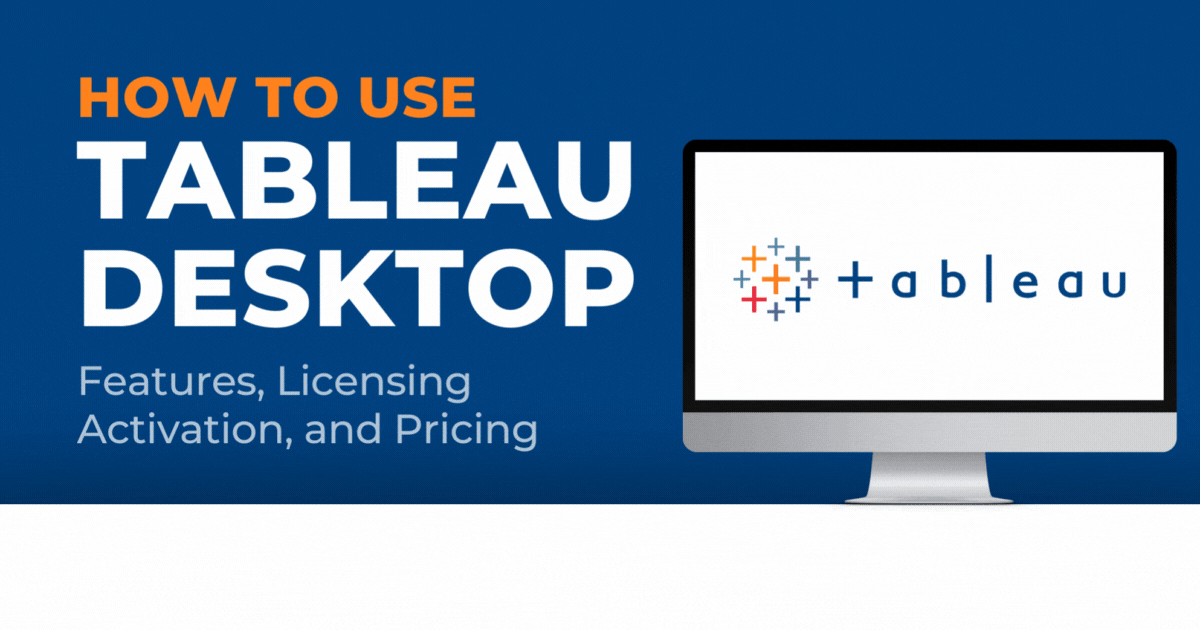Tableau Conference 2025 | Know Before You Go
If you’re a data enthusiast, analytics professional, or just someone curious about Tableau’s latest innovations, the Tableau Conference 2025 is your...
5 min read
 Luke Komiskey
May 12, 2023
Luke Komiskey
May 12, 2023

Unlock the power of data visualization with Tableau Desktop to transform raw data into meaningful insights for data-driven organizations of all sizes. Tableau Desktop, a leading platform within data analytics, has emerged as a top choice for businesses due to its user-friendly interface, powerful analytical capabilities, and a broad range of data connection options.
However, navigating the complexities of Tableau Desktop licensing, pricing, and activation can be challenging, especially for those who are new to the platform.
We'll demystify Tableau Desktop by exploring functionality, pricing, activation processes, and more. Plus, we'll tackle the important questions to help you determine if Tableau is the perfect fit for your organization. By the end of the post, you'll be a Tableau Desktop pro, ready to maximize your Tableau investment. Let’s jump in!
Tableau Desktop is a powerful data visualization and analytics software that enables users to create interactive and shareable dashboards, reports, and charts. It empowers individuals and organizations to transform raw data into meaningful insights, allowing for better decision-making and improved business performance.
With an intuitive drag-and-drop interface, Tableau Desktop makes it easy for users of all skill levels to explore, analyze, and visualize data. Its compatibility with numerous data sources, such as databases, spreadsheets, and cloud services, ensures a seamless data visualization experience, regardless of your organization’s data strategy maturity and business application ecosystem.
Easy-to-use interface: Tableau Desktop's user-friendly drag-and-drop interface simplifies the process of creating visualizations, even for those with little to no prior experience in data analysis. No SQL knowledge is required as Tableau automatically creates complex SQL statements with its proprietary vizQL technology.
Wide range of data connections: Tableau Desktop supports connections to various data sources, including databases, spreadsheets, cloud applications, and big data platforms. For non-standard connections, Tableau provides the ability to leverage web data and ODBC/JDBC connectors alongside 3rd-party connectors on the Tableau exchange.
Long story short, Tableau connects to your data.
Advanced analytical capabilities: Tableau Desktop provides a range of analytical tools, such as forecasting, clustering, and trend analysis, to help users uncover deeper insights from their data - all without needing prior R or Python programming knowledge.
Custom calculations: Perform complex calculations and create custom formulas to derive deeper insights based on the unique needs of your organization and the structure/quality of underlying data sources.
Interactive dashboards: Build dynamic, bespoke business dashboards that allow users to filter, highlight, and drill down into data with fast performance speeds.
Customizable visualizations: Tableau is known for its ability to build beautiful custom visualizations that best visually present data-driven insights. Users can create a variety of visualization types, including bar charts, line charts, pie charts, maps, and more, with the ability to import even more custom options through Tableau extensions.
Collaboration and sharing features: Tableau Desktop allows users to share their visualizations and insights with others through various sharing options, including Tableau Cloud, Tableau Server, and Tableau Public (for public data only).
Tableau Prep is a data preparation tool within the Tableau product suite designed to help business analysts clean, shape, and combine data for analysis in Tableau. With its visual and intuitive interface, Tableau Prep makes it easy to spot data issues, apply transformations, and create a clean, analysis-ready dataset for Tableau, spreadsheets, or some databases.
Tableau Prep exists because raw data is rarely structured or clean enough to be used directly in Tableau Desktop. While Tableau Desktop is capable of calculations to fix bad data, Tableau Prep is used for cleaning, shaping, and preparing data before diving into analysis with Tableau Desktop. Use Tableau Desktop when you need to create visualizations, analyze data, and build interactive dashboards.
Tableau Cloud is a cloud-based self-service analytics platform that enables users to create, share, and collaborate on visualizations and dashboards without the need for any on-premise infrastructure. With a Tableau Creator license type (see next section), Tableau Cloud also offers the same powerful analytical and dashboard-building capabilities as Tableau Desktop.
Tableau provides the ability for developers to create dashboards either within Tableau Desktop or Tableau Cloud, via a ‘Tableau Desktop experience’ built in the browser. Tableau has continued to create feature parity between the desktop application and browser, and I’d estimate the experience is about 90% the same between both experiences.
There are still a few differences between menu options and easy access to dashboard development features within Tableau Cloud's dashboard-building experience. I still highly recommend downloading the Tableau Desktop application for creating dashboards, particularly if creating Tableau visualizations is the majority of your organization’s role.
The Tableau Creator license provides a breadth of Tableau software that includes Tableau Desktop, Tableau Prep, and access to Tableau Cloud (each Tableau Cloud deployment requires at least one Creator purchase). Tableau Desktop is available for download for anyone that has the Creator license - or anyone that wants a free 14-day trial of the software. As of 2023, the Tableau Creator license list price is $70 per user per month (billed annually), which includes Tableau Desktop, Tableau Prep, and Tableau Cloud.
The next pricing tier from Creators is called Tableau Explorer, which provides the browser-based ‘Tableau Desktop experience’ within Tableau Cloud. Tableau Explorers do not have the ability to connect to net-new data sources and will require partnering with the Creator-licensed people within the organization.
To activate your Tableau Desktop license, follow these simple steps:
Install Tableau Desktop: Download and install the latest version of Tableau Desktop from the Tableau website. Ensure that your computer meets the minimum system requirements for the software.
Launch Tableau Desktop: Open Tableau Desktop on your computer. If this is your first time launching the software, you will be prompted to sign-up for a trial or register with your existing email. The register option is a small link in the subheader that is often overlooked!
Enter Tableau Cloud email/password: Sign into Tableau Cloud using the same account credentials you set up when you logged into Tableau Cloud. Tableau uses email/password to register Tableau Desktop and access Tableau Cloud.
Start using Tableau Desktop: After successfully activating your license and signing in, you can begin using Tableau Desktop to create and share stunning data visualizations. If you are new to Tableau Desktop, take advantage of provided resources on the main landing page, like official training video links, sample workbooks, and Tableau Public’s viz-of-the-day for inspiration.
If nothing else works, at least take advantage of registering for the 14-day trial to use the full functionality of Tableau Desktop while activation issues are resolved. All of your development work will continue to operate as expected after the trial expires or is not needed.
Tableau Desktop has become an indispensable tool for businesses looking to harness the power of data visualization and make data-driven decisions. In this comprehensive guide, we've explored the key functionalities of Tableau Desktop, comparing functionality vs. Tableau Prep and Tableau Cloud, and provided insight into licensing, pricing, and activation.
Mastering Tableau Desktop can be a game-changer for your organization's data analysis capabilities. So, dive in, start exploring, and unlock the full potential of your data with Tableau Desktop.
DataDrive has helped over 150 organizations unlock the full potential of Tableau and ensure teams are well-equipped to leverage the power of Tableau Desktop. Reach out to our Premier Tableau Partner team to get started.
Is Tableau Desktop free?
Tableau Desktop is not free; it is bundled with the Tableau Creator license, which costs $70 per user per month (billed annually) - as of May 2023.
What is the difference between Tableau Desktop and Tableau Cloud?
Tableau Desktop is a locally installed data visualization tool, while Tableau Cloud is a cloud-based platform for creating and sharing visualizations and dashboards. Tableau Cloud offers a ‘Tableau Desktop experience’ directly in the browser for appropriately-licensed users.
What is the difference between Tableau Desktop and Prep?
Tableau Desktop is designed for crafting data visualization and analysis, while Tableau Prep is a data preparation tool for cleaning, shaping, and combining data before analysis within Desktop.
How does Tableau licensing work for Tableau Desktop?
Tableau Desktop is included with the Tableau Creator license, which also provides access to Tableau Prep and Tableau Cloud. Anyone can download and test out Tableau Desktop with a 14-day trial.
Does Tableau Desktop require a license?
Yes, Tableau Desktop requires a Tableau Creator license for use.
How much does a Tableau Desktop license cost?
A Tableau Creator license, which includes Tableau Desktop, costs $70 per user per month (billed annually) as of May 2023.
What is Tableau Desktop used for?
Tableau Desktop is used for creating data visualizations, analyzing data, and building interactive dashboards.
Is Tableau Desktop free?
No, Tableau Desktop is not free and requires a Tableau Creator license. Anyone can download and test out Tableau Desktop with a 14-day trial.
How do I download Tableau Desktop?
Download Tableau Desktop from the official Tableau website. After downloading, install the software on your machine and follow the activation steps mentioned in this blog post.
-2.gif)
If you’re a data enthusiast, analytics professional, or just someone curious about Tableau’s latest innovations, the Tableau Conference 2025 is your...

Tableau Plus is the new premium offering from Tableau, a leading data visualization and business intelligence platform. It builds upon the...

If you've spent any time working with Tableau, you've likely encountered the dreaded "Cannot Mix Aggregate and Non-Aggregate Arguments" error. It's a...